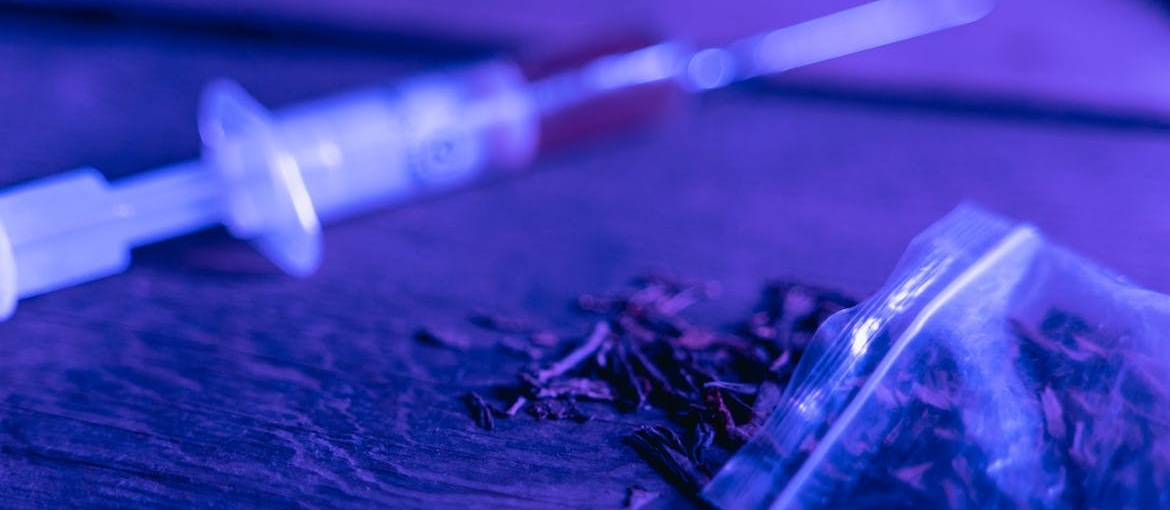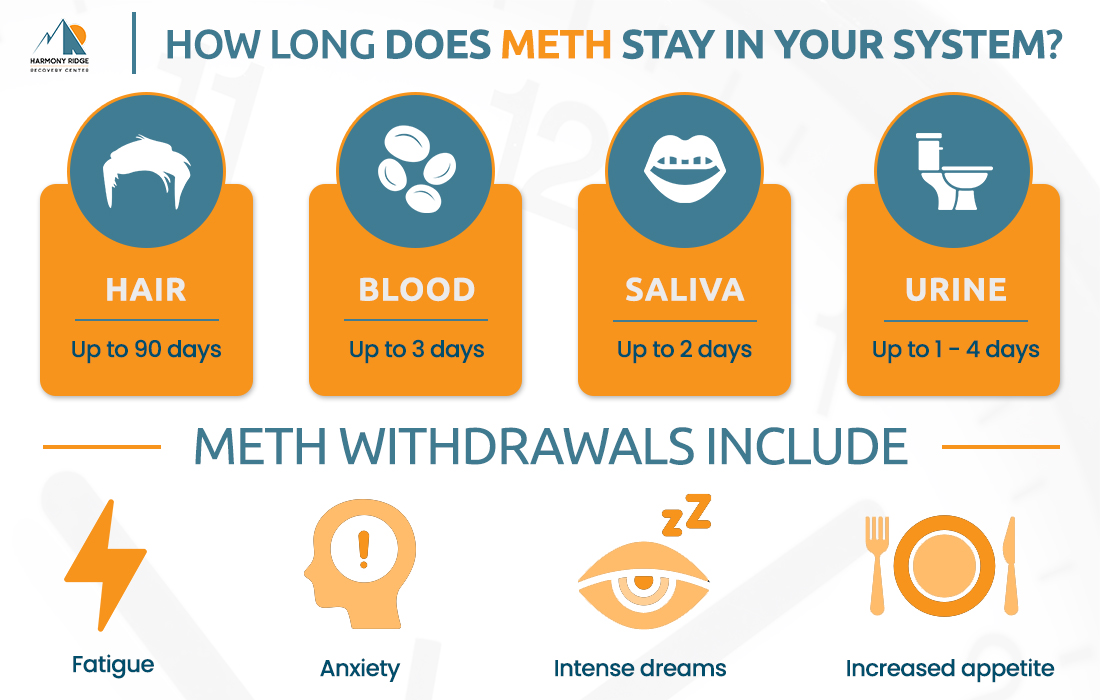How Long Does Meth Stay in Your System?
The process of completely getting rid of meth from your system may vary depending on various factors. Harmony Ridge Recovery Center WV is here to explain everything.
Are you finally considering quitting your meth addiction and wondering how long the drug stays in your system? First, congratulations on making a very significant decision. Second, there are some important things you need to know before you try to do it alone or try to help someone you care about. Support from a place like Harmony Ridge Recovery Center WV can make the process safer and more manageable.
The effects of methamphetamine can last for many hours and might actually take up to 4 days for the drug to completely leave your body. Methamphetamine has an average half-life of 10 hours. However, when considering how long does methamphetamine stay in your system, it’s important to understand several factors. This means that it takes 10 hours for half the drug to exit the system.
However, metabolites can show up in blood tests for days after use. (Metabolites are produced when the body breaks down food, drugs, or chemicals.) Different drug tests have variable detection times. One test may show a positive urine test result after a single use for up to 4 days after use, but a hair test may be positive up to 3 months later.
Binge and Crash
Meth is sometimes used in a “binge and crash” pattern. What this means is that the pleasurable effects of the drug start to wear off even before the drug is completely processed. Frequently, people will try to maintain their high by using more. A “run” refers to taking the drug over several days and staying awake the entire time. This leads some people to ignore the need to eat, hydrate, rest, or keep up their hygiene during that period. How long methamphetamines stay in your system depends on several factors. They are:
The Way It’s Used
The method used to consume meth is directly related to how quickly you feel the effects. Methamphetamine can be consumed in various ways and it will typically take several days for the drug to exit the system completely. It can be:
- smoked
- snorted
- injected
- swallowed
- rectally
When meth is swallowed, the highest concentration is within 2-4 hours. When snorted, smoked, or injected, the peak concentration will happen within minutes. Smoking, snorting, injecting, or inserting rectally allows the drug to reach the brain faster which causes an intense and immediate “rush.” That’s why smoking or injecting meth has a greater likelihood of addiction. Snorting or swallowing brings about feelings of euphoria but not the rush that smoking or injecting does.
Frequency of Use
People who use meth frequently will have longer detection times than someone who only uses it once.
Is It Combined With Other Substances?
Very often, people use meth with other substances. Combining substances can change the effects of methamphetamine on the body and how you feel. Some people drink alcohol and take meth together to ease the jitteriness that meth causes. Still, alcohol inhibits the metabolism of meth, meaning that it will take longer for methamphetamine to leave the body if someone uses alcohol with it.
Sometimes, addicts combine meth with:
- other stimulants such as cocaine or MDMA or
- opiates like heroin, or other drugs such as
- GHB
- poppers
- ketamine
- using drugs as part of your sex life
Combining methamphetamine with other drugs can have unpredictable and sometimes harmful effects on your body. Polysubstance use often requires specialized substance abuse treatment WV programs to manage safely. It also lengthens the time it takes for all the drugs to leave your system.

Is It Prescription or Illicit?
The effects of illicit methamphetamine are very different from prescription methamphetamines or amphetamines such as Adderall or Desoxyn. Adderall’s effects are usually felt within 45-60 minutes of swallowing the tablet, and the effects don’t typically last longer than 4 to 6 hours. On the other hand, the effects of illicit meth can be unpredictable since what is often sold as methamphetamine is of unknown quality and strength and could include other substances or additives.
Overall Health
An individual’s general health, including liver and kidney function, can make a difference in how quickly meth is processed and cleared from your body.
Rate of Metabolism
People with a high metabolism tend to process and excrete meth quicker than those with a slower metabolism. Activity level, age, and general overall health can all play a part in your metabolic rate.
How Long Does It Take?
Many people ask how long does meth stay in system after they stop using. With all that being said, in general:
How long does meth stay in your hair?
If you’re wondering how long is meth in your system overall, it helps to look at different types of drug tests. Testing hair follicles is one of the best ways to check for drug use. Especially since it will show some of the drugs for up to 90 days after use. You can wash, cut, or dye your hair and it will still show up. The hair follicle uses your blood for nutrition and if you consumed meth, it will be evident in the follicle.
How long does meth stay in your blood?
Blood testing for meth is rarely used but there are times when blood will be taken and tested. Crystal meth (the crystallized or powdered form that is most popular) that has been smoked, snorted, or injected will show up immediately in the blood. It can stay in your blood and show up as a positive result for up to 3 days.
How long does meth stay in your urine?
Urine tests are the most common way to check for drug use. Your kidneys are responsible for flushing the drug from your system so it will show a notable number of metabolites. On average, after a single use of meth, it will be present for 1 to 4 days. And for heavy use, it could be up to a week.
How long does meth stay in your saliva?
Similar to most drugs, meth can be detected in your oral fluids (saliva). It can be detected for up to 2 days after using it.
Methamphetamine Detox and Withdrawal
Meth is a powerful, highly addictive drug and people who are addicted to it need a medication assisted treatment West Virginia detox center with medical supervision to stop using it. Withdrawal is a very uncomfortable process that begins as soon as you stop using it. A residential treatment center West Virginia offers can provide a safe space for managing these symptoms. But there are predictable symptoms that wear off as the body detoxifies.
According to users who have quit, withdrawal causes severe emotional and physical symptoms. They all agree that nothing is more difficult than coming down from a meth binge. The cravings for meth, depression and anxiety are intense. If a withdrawal is not done in a safe and secure detox facility, most people will return to the drug as soon as they can.
There are other factors that also play a role in the length and severity of meth withdrawal. They include:
- The mental health of the person before and during meth use. Dual mental health and substance issues may require dual diagnosis treatment West Virginia programs.
- The quality of the meth being used.
- Whether the person has a history of other drug use, including alcohol.
- How long the individual has been using meth.
- How much the person has been using.
- How severe the dependence is.
- The person’s age. Older people generally experience worse symptoms.
Meth Withdrawal Symptoms
Typical symptoms of meth withdrawal include:
- Fatigue–People are usually very inactive, tired, and sleepy, particularly during the first week of withdrawal. It usually peaks around the fifth day of withdrawal and it isn’t unusual for the person to sleep an average of 11 hours per day.
- Intense dreams–It’s normal for people to have vivid dreams during this time. They will typically lessen during the first week.
- Increased appetite–People frequently lose their appetite while on meth but that changes during withdrawal. At this time they will have a strong craving for carbohydrates (sugary or starchy food). This is common at the start of withdrawal and usually lasts into the second or third week.
- Anxiety–It is common for individuals going through meth withdrawal to have anxiety disorders. Research indicates that the rates of anxiety disorders among people who use meth may be as high as 30%.
- Depression–Having a low or depressed mood is also normal while going through withdrawal. It should be gone by the end of the third week for most people, but it could continue for some.
- Psychosis–Psychosis can be a symptom of meth withdrawal. It is mainly made up of hallucinations–seeing, hearing, and feeling things that aren’t there. It also includes delusions–thoughts that seem true but in reality, are not.
- Cravings for the drug–People withdrawing from meth feel strong cravings to use more. Cravings are common when withdrawing from an addictive substance
Phases of Withdrawal
- Come-down or crash -Your body will be completely without energy for the first 1 or 2 days and may sleep continually.
- Depression symptoms -You will continue to be tired but with feelings of paranoia and depression. This should decrease in about 10 days. Many times a person will become so depressed they will use again rather than go through withdrawal.
- Sub-acute withdrawal -This is also sometimes called the “Persistent Symptoms Period.” There may be sleep or appetite problems. During this phase, some may benefit from an intensive outpatient program West Virginia facilities offer. Bradycardia (abnormally slow heartbeat) might be present for several weeks after the last usage causing fatigue, lightheadedness, shortness of breath, or confusion.
- Post-acute withdrawal syndrome -Even after acute withdrawal has passed, PAWS can occur months after recovery. This is a temporary condition that is often triggered by places, people, or situations that remind the person of using and lasts a few days.
Consequences of Meth Addiction
If you’re still on the fence about quitting, you should consider these studies of the consequences for chronic meth users:
- Research shows severe structural and functional changes in the areas of the brain linked to emotion and memory. This helps explain the emotional and cognitive problems seen in meth users.
- Studies with primates showed that the brain structures involved in decision-making and habitual behaviors explain the decline in mental flexibility. Changes in brain structure and function like this might account for meth addiction recovery being so difficult to treat and the high rates of relapse.
- Some of the brain cell effects of chronic use seem to be somewhat partially reversible and biochemical markers for nerve damage in the brain return to normal after a year of more sobriety. On the other hand, meth use increases the risk of stroke, which does irreversible damage to the brain.
- Long-term meth users also show physical effects including weight loss, tooth decay and loss (known as meth mouth), and skin sores. The combination of poor nutrition and dental hygiene along with a dry mouth and teeth grinding may be the cause of dental problems.

Getting Treatment for Meth Addiction
Quitting any addictive drug is hard work. And quitting meth is an extremely challenging recovery path. Staying on the road to life-long recovery requires experienced, professional guidance and you can find that at Harmony Ridge Recovery Center WV.
Harmony Ridge Recovery Center WV can offer you a safe, secure facility to go through the trials of detox along with three levels of treatment programs as well as case management. Our medical professionals and addiction specialists will help you every step of the way to make your journey as easy, enlightening, and successful as possible. You just have to contact us. For yourself or someone you love.
Contact Us TodayJump To Section
Begin Your Journey to Healing Here
Ask me about recovery, I can help you!
Our recovery specialists are standing by 24/7 to help you or your loved one.
Or call us: 




